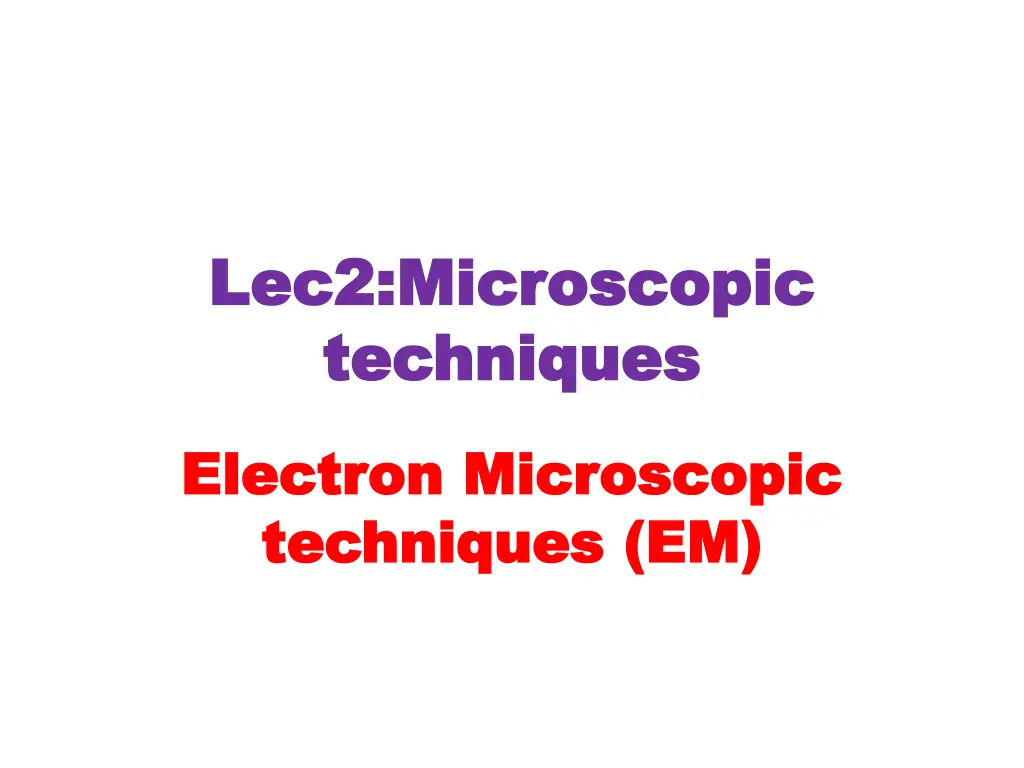
Explore Electron Microscopic Techniques for Detailed Cell Observation
Discover the world of electron microscopic techniques, such as scanning electron microscopy (SEM) and transmission electron microscopy (TEM), that enable in-depth exploration of cells, organelles, and specimens at a magnification and resolution far beyond traditional light microscopy. Learn about the advantages, disadvantages, and components of electron microscopes used in various industries and scientific laboratories.
Download Presentation

Please find below an Image/Link to download the presentation.
The content on the website is provided AS IS for your information and personal use only. It may not be sold, licensed, or shared on other websites without obtaining consent from the author. If you encounter any issues during the download, it is possible that the publisher has removed the file from their server.
You are allowed to download the files provided on this website for personal or commercial use, subject to the condition that they are used lawfully. All files are the property of their respective owners.
The content on the website is provided AS IS for your information and personal use only. It may not be sold, licensed, or shared on other websites without obtaining consent from the author.
E N D
Presentation Transcript
Lec2:Microscopic Lec2:Microscopic techniques techniques Electron Microscopic Electron Microscopic techniques (EM) techniques (EM)
2020-2021 Electron electron beam which is focused into a small probe across the surface of a specimen. The first electromagnetic lens was developed in 1926 by Hans Busch. Electron microscope follows the same principle microscope, but beam as an illumination instead of light. microscopy (EM) is an of compound electrons source uses
Electron microscopes allow biologists to explore cells in more details To observe the organelles such as: Mitochondria, Ribosomes, Endoplasmic reticulum (ER), Golgi apparatus and Lysosomes. Heavy metals (such as lead) are used to stain cells prior to examine via EM. The stain is more visible in organelles than in the surrounding cytoplasm. Defects in a cell s organelles are easily seen
Electron microscopes are used in the scientific laboratories and many industries, such as forensics, nanotechnology and mining. Disadvantages of electron Disadvantages of electron microscopes microscopes 1- It is a large machines 2- Training is required 3- It is very expensive 4- Specimens are required a lot of preparation. 5- The specimens are mounted in plastic, which means that only dead cells can be viewed.
There are two types of There are two types of electron microscopes electron microscopes Scanning Scanning electron electron microscope The mode of action for the SEM is similar to compound however, an electron beams behave like waves which focus via using a magnetic field rather ordinary lenses. required for the biological specimens. The electron microscopes are used to achieve up to 100,000x magnification and more than 1000 x resolution than the light microscope. microscope (SEM) (SEM) microscope than uses of is Metallic coating
Components of the SEM Components of the SEM 1- Lens: It is an electrical field and are not the optical materials (like glass Electron optics: a- Condenser lens: It is focusing the electron beam to the objective lens. b- Objective lens: It is responsible for size of electron beam impinging on sample surface 2- Electron beam. 3- Transducers (detectors).
2 2- - Transmission Electron Transmission Electron Microscope: Microscope: In transmission electron microscopy (TEM), a beam of highly focused electrons are directed toward a thinned sample (<200 nm). Normally no scanning required helps the high resolution, compared to SEM. Advantages: Advantages: 1- TEMs offer the most powerful magnification, potentially over one million times or more 2- - Direct imaging of crystalline lattice. 3- No metallic stain-coating is needed, thus convenient for structural imaging of organic materials.
4- Images are high-quality and detailed. 5- Electrons can only travel through a vacuum, so the specimen must be completely dehydrated. 6- Electrons have poor penetrating ability which the image contrast results when electrons are scattered by the specimen. Therefore specimens are usually stained with a coat of heavy metal (uranium, osmium, and tungsten) to increase scattering ability. Disadvantages: Disadvantages: TEMs are large and very expensive Images are black and white The preparation is limited to an electron- transparent sample (due to the conductivity or electron density, and sample thickness).
New Techniques in New Techniques in Microscopy: Microscopy: Confocal Confocal Microscopy ( Microscopy (Confocal Scanning Laser Microscope) Scanning Laser Microscope) Laser scanning confocal microscopy is an invaluable tool for a wide range of investigations in the biological and medical sciences for imaging thin optical sections in living and fixed specimens ranging in thickness up to 100 micrometers. The basic concept of confocal microscopy was originally developed by Marvin Minsky in the mid-1950s (patented in 1961) when he was a postdoctoral student at Harvard University as Minsky wanted to image neural networks in unstained preparations of brain tissue. The basic key to the confocal approach is the use of spatial filtering techniques to eliminate out-of-focus light or glare in specimens whose thickness exceeds the immediate plane of focus Confocal
Advantages of using Advantages of using confocal confocal microscope microscope Confocal microscopy offers several advantages over conventional wide field optical microscopy: sections from thick specimens. The ability to control depth of field, elimination or reduction of background information away from the focal plane. The capability to collect serial optical
Transmission Electron Transmission Electron Microscope (TEM) Microscope (TEM) Scanning Electron Scanning Electron Microscope (SEM) Microscope (SEM) Pass a beam of electrons over the surface of the specimen in the form of a scanning beam. Electrons are reflected off the surface of the specimen as it has been previously coated in heavy metals. It is these reflected electron beams that are focused of the fluorescent screen in order to make up the image. Larger, thicker structures can thus be seen under the SEM as the electrons do not have to pass through the sample in order to form the image. This gives excellent 3- dimensional images of surfaces Pass a beam of electrons through the specimen. The electrons that pass through the specimen are detected on a fluorescent screen on which the image is displayed. Thin sections of specimen are needed for transmission electron microscopy as the electrons have to pass through the specimen for the image to be produced. This is the most common form of electron microscope and has the best resolution However the resolution of the SEM is lower than that of the TEM.
Light Microscope Light Microscope Electron Microscope Electron Microscope Cheap to purchase Expensive to buy Expensive to produce electron beam. Large and requires special rooms. Lengthy and complex sample prep. Preparation distorts material. Cheap to operate. Small and portable. Simple and easy sample preparation. Material rarely distorted by preparation. Vacuum is not required. Vacuum is required. Natural color of sample maintained. All images in black and white.






















